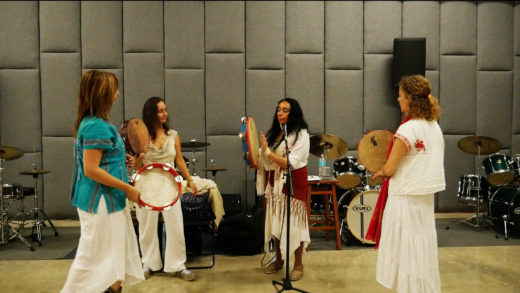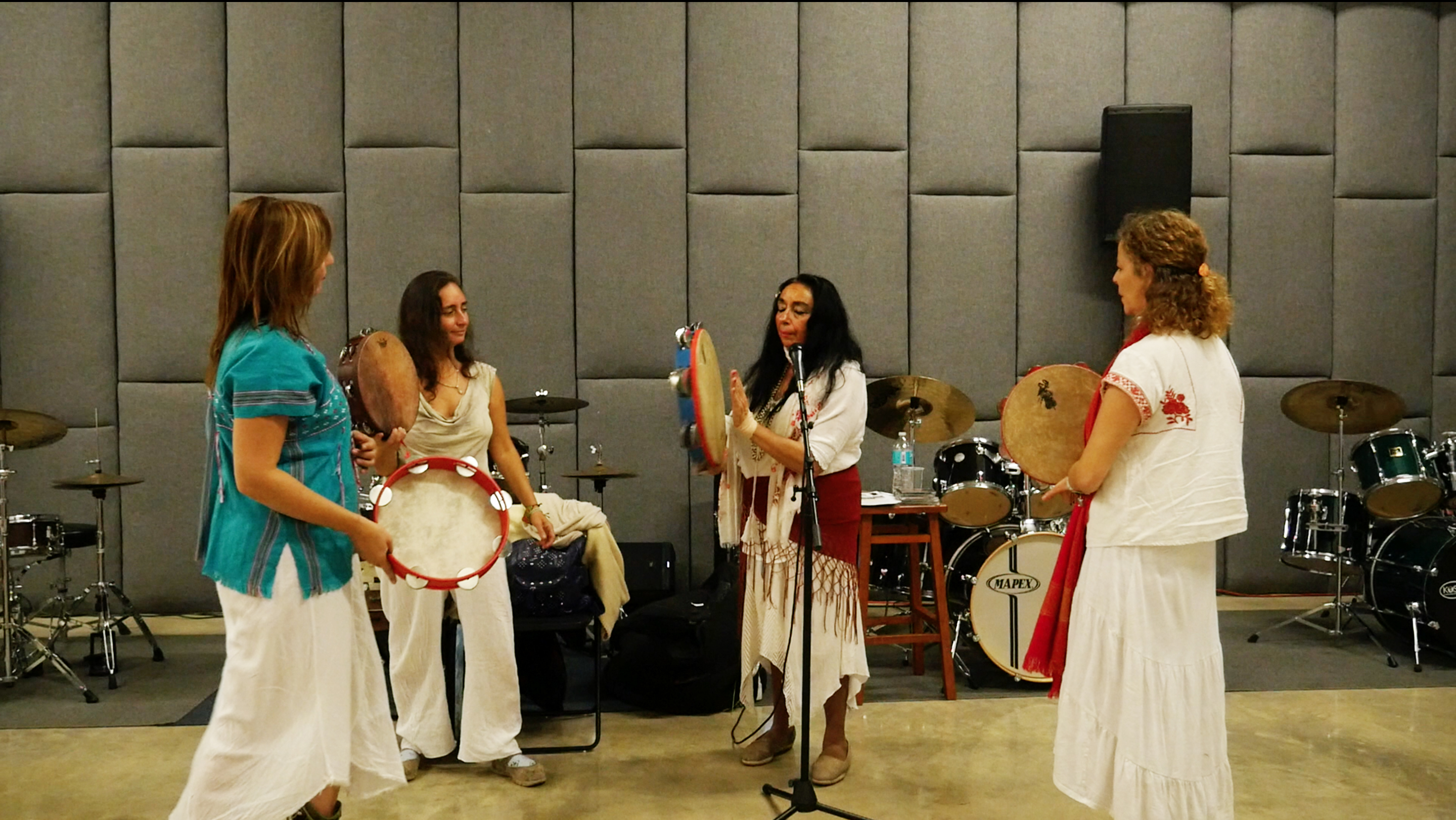Drumming for the Black Madonna
JOHN HENRY DALE
 Alessandra Belloni in the workshop
Alessandra Belloni in the workshop
Brandon Cruz, Director of SFCPA, greets me at the door and explains that the non-profit drumming education center has carved out a small but growing core of supportive members and students. Although Cruz is a seasoned drummer and percussionist, the Tarantella is new to him, too. The SFPCA is one of the only education centers in South Florida specifically built for percussion. But with its tall warehouse ceilings, industrial fluorescent lighting, and five complete drum sets lining the back wall, the SFPCA’s main rehearsal room doesn’t seem to be the most intimate setting for a workshop whose self-described objective is “teaching the chanting, dancing and…beautiful sensual dances in honor of the Black Madonna.”

Shortly after Cruz gives me the tour of the facility, four more people arrive: Alessandra Belloni accompanied by three other women, each dressed in blue and white linen dresses, carrying tambourines, and expressing an earnest desire to learn and perhaps to heal. After introductions and preparation of the room, Belloni begins the workshop with an explanation of the Tarantella and some basic tambourine playing techniques, then moves into the more complex 6/8 phrasing typically employed in Tarantella dances. The attendees prove to be quick studies; within an hour, the workshop moves into the dancing and singing component.
Taking its name from the Italian town of Taranto, the Tarantella has a complicated history as both a dance mimicking courtship rituals, and as an ecstatic movement expression with pagan roots, which could last from hours to days long. The ecstatic interpretations came to be performed and accompanied with violins, frame drums, cymbals, and trumpets, often played frenetically around a woman rolling convulsively on the ground. This ecstatic and erratic movement was believed to cure the delirious state attributed to the bite of a Lycosa tarantula spider during the summer harvest, but Belloni and other practitioners share the view that this “healing” Tarantella dance likely originated as a way to disguise its pagan ritualistic origins after pagan practices were banned by the Roman Empire. Towards the sixteenth and seventeenth centuries, the dance was applied as a supposed cure for the behavior of neurotic women under the name carnevaletto delle donne.
The Tarantella’s musical history is also complicated by its widespread adoption into the classical music canon. As often occurs with popular folk music forms across Europe, many classical composers borrowed from this southern Italian musical tradition and incorporated Tarantella elements into ballets, concertos, suites, and symphonies. Britten, Chopin, Debussy, Liszt, Mendelssohn, Prokofiev, Rachmaninoff, Rossini, Saint-Saëns, Schubert, and Tchaikovsky all felt the bite of the Tarantella. Prokofiev’s ballet version of Romeo and Juliet even contains a Tarantella dance scene.
However, Belloni’s main focus is on the healing aspect of Tarantella, and classical music is not on the program tonight. The only instruments in play here are the voice and the drum. After the dance portion of the workshop is over, Belloni shares with me that she began her professional career as an actress in New York before discovering southern Italian folk music the late 1970s. After becoming, as she puts it, “bewitched by a tambourine player from Sicily, ” Belloni shifted her focus to playing the tambourine and learning the folk music and dance traditions of Southern Italy. She began playing professionally by 1979, around which time she met a classical guitarist named John La Barbera who led an Italian folk group based in Puglia that focused on Tarantella.
This musical encounter changed Belloni’s life. She explains that it “touched something really deep” in her heart and soul. She and La Barbera subsequently started a group in New York called I Giullari Di Piazza (The Players of The Square) which combined southern Italian folk music, dance and a form of improvisational theater known as Commedia dell’Arte. Concurrently, Belloni began to concentrate on her own historical research of Italian and Mediterranean music, dance and theater. While there is abundance of both modern ethnomusicological and ancient writing on these areas, much of the knowledge of folk music and dance in southern Italy is still passed down through oral tradition.
Every summer, Belloni would travel around the south of Italy to interview village elders, farmers, and festival goers about the Tarantella and its associated traditions. As she went from town to town to perform at different music festivals, she noticed commonalities in the spiritual aspects of this multifaceted musical form. In many of these towns, Belloni found a statue or painting of a Black Madonna, usually located in or near the local church. She discovered that the most powerful “healing” Tarantella rituals she would experience involved frame drumming and were performed in honor of the Black Madonna. Although Belloni is Italian and grew up in Rome, she had not previously encountered any of the Italian Black Madonnas until she returned to southern Italy as a touring musician.
A number of books have been written on this subject of the Black Madonna, and a book from Belloni, tentatively titled God is a Woman and She is Black, is also forthcoming. One prominent theory by Stephen Benko, author of The Virgin Goddess, argues that the Black Madonna is essentially a Christianized version of the archetypal ancient earth-goddess. Benko also notes that many goddesses were pictured as Black, including Artemis, Isis, Ceres, and Cybele. Ceres, the Roman goddess of agriculture, grain crops, and motherly relationships, is particularly significant. The Greek name for Ceres, Demeter, derives from Ge, Da, or De (Earth) and Meter (Mother). Another common association is that the most fertile soil is dark or black in color, therefore the darker the earth, the better suited it is for growing food.
Another often cited text, The Cult of The Black Virgin by Ean Begg, illustrates that there are many black Madonna sculptures or paintings throughout the world, with estimates ranging between 400-500 sites, from Russia to Trinidad and Tobago. They are mainly found in Catholic or Orthodox countries, with a large percentage of those in France, Spain, Germany, and Italy. Belloni shares Benko’s view of the Black Madonna as being a Christianized version of pagan fertility goddesses, and adds that the Phrygian/Anatolian “Mother of the Gods” Cybele was another pre-Christian fertility goddess strongly linked with both Ceres and the male god of fertility and ritual madness, Dionysus — or Bacchus as he was known in Roman mythology.
It is important to note that while comparative religion and New Age movements have tended to conflate Jesus and Mary’s stories with various pagan myths and traditions, there are key differences. Whether or not one believes in the possibility of a virgin birth, the resurrection of the dead to eternal life, or the ability of Jesus to be both man and the son of God, Christians, as well as the vast majority of historians, will agree that Mary and Jesus were, in fact, real human beings who lived and died.
On the other hand, Isis, Ceres, Cybele and other divine heroes and heroines of the Greek and Roman mythological pantheon were not human beings but gods, and venerated as such. So, while it’s indisputable that banned pagan music and dance rituals involving Cybele, Ceres or Dionysus began to change form after they became taboo under the increasingly Christianized Roman Empire, it’s inaccurate to say that the Virgin Mary is just “another version” of Cybele, Isis or Ceres. These pre-Christian pagan goddesses had already been worshipped for centuries before Mary was even born. And Mary had a life that was, by all accounts, very different from all the aforementioned fertility goddesses. People did not actually believe that Cybele or Isis became or transformed into Mary. It’s more the case that the worship of fertility goddesses was transformed to become a worship or adoration of Mary because she was the only holy “mother of God“ figure legally sanctioned by the empire in a time when worshipping pagan gods and goddesses was punishable by death.
Literature describing the rites of Cybele often mention ecstatic submission to the loud, percussive music of tympanon (tambourines), castanets, cymbals and flutes, and a form of circle-dances by women, to the music of the gods. These images conjure similarities to the Tarantella dances that Belloni encountered in her travels throughout southern Italy. Given the Roman Empire’s ban on pagan rituals, it’s not hard to imagine generations of recalcitrant villagers coming up with ever more creative ways of disguising their ritual music and dances as a kind of healing practice.
And while the music is certainly joyous and percussive, Belloni has found, both in her travels to Tarantella festivals in Italy and in her own Tarantella workshops around the world, that these rituals are real therapeutic exercises with astonishing results. She mentions that a significant number of her female workshop participants have been the victims of rape, sexual abuse, domestic violence and incest. And in many cases, her workshops have helped to heal their emotional or physical traumas.
Belloni describes her own experience with the palliative power of the Black Madonna and the Tarantella that originally inspired her to start doing the healing Tarantella workshops. In 1986, she endured cancer followed by an extended recuperation process. During this time, she experienced a vision of the Black Madonna telling her that she would heal herself by healing others. She began to practice ecstatic dance and found that the internal bleeding she experienced as a result of a reappearance of the cancer had stopped. Perhaps, she thought, her dance practice could also help other women to heal from their own medical issues. She describes instances of women whose cysts disappeared and fertility issues resolved after participating in the Tarantella workshops, as well as how they were able, through frenzied physical movement, to cure themselves of profound emotional injury.
“I started to have experiences of many women coming to me, without me knowing it, who had been abused and raped with horrifying stories,” Belloni tells me. “That trance dance, which is on the ground, rolling around and becoming the spider, with legs up in the air, it’s very erotic, very sensual. During that part of the trance, the women let go of their trauma if they let go of their mind. Something happens, the body expels the trauma, lets it go out. And the experience that has been incredible is that these women come out, not only out of the trauma, out of the depression, but then transform their life and begin a completely different life.”
Dancing has, of course, long been associated with happiness and good health, but a number of recent scientific studies point to the fact that it may well have direct and measurable physiological and psychological benefits as well. None of this is news to Belloni, who has been practicing these healing dance music workshops for nearly thirty years now. Given her long history with the Tarantella and her indefatigable mission to share it with as many people around the world as possible, I am curious if she has found any promising apprentices to whom she can pass on her teachings.
“I’m still searching for a young woman to take it on. It hasn’t happened,” Belloni says. But she hopes that her two upcoming projects, her book on the Black Madonna and a film she’s been writing to be a documentary or TV series featuring the stories of women whose lives have been changed through the Tarantella, will help spread her message of healing. “I believe the camera is a great media and the people watching, whether it’s online or on television, will receive the power of this ancient music and dance tradition. And my aim is to bring it to the world to help. It’s meant to be that way.”
John Henry Dale is the Music Editor for The Miami Rail.










